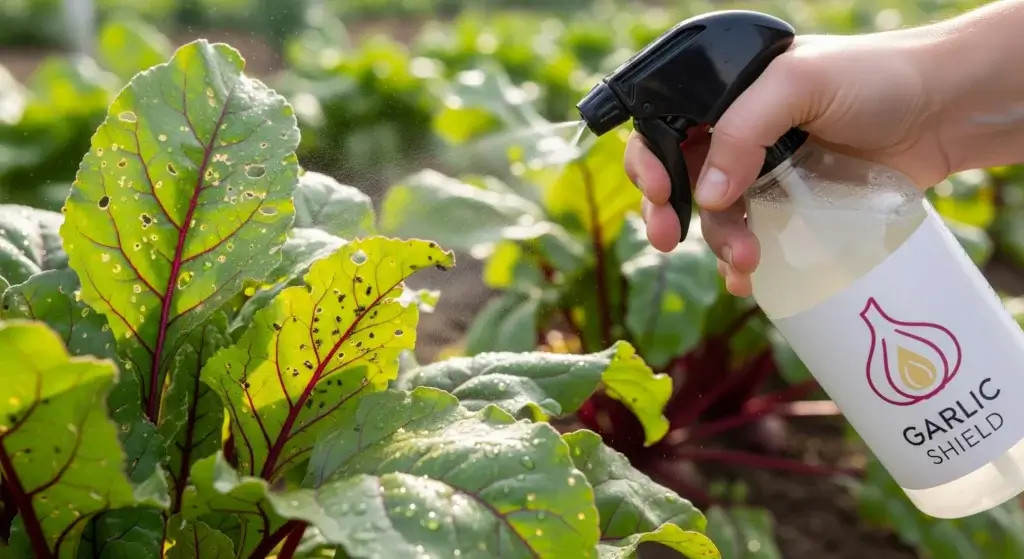
Aphids are like the freeloaders of your garden—tiny, greedy, and totally unwelcome.
They suck the life out of your plants and throw virus parties on the side. Yikes.
But instead of going full Breaking Bad with chemical sprays, you can go full garlic grandma.
Garlic spray = your garden’s spicy, all-natural bodyguard.
It’s cheap, safe, easy to make, and doesn’t kill your garden’s good guys (shoutout to ladybugs).
So skip the pesticides. Make garlic your garden’s new superhero. Aphids won’t know what hit ‘em.
Why Garlic Works Against Aphids?
Garlic isn’t just for warding off vampires and flavoring your pasta—it’s also your garden’s secret weapon.
Why? One word: allicin.
That’s the super-smelly sulfur compound in garlic that makes bugs gag and bounce.
Mites, whiteflies, and even some funky fungi? Same story.
Garlic basically throws a “No Pests Allowed” sign on your plants—without hurting your veggies, herbs, or bee friends.
Perks of garlic spray:
- Gives aphids the boot—naturally and gently
- Fights mold and mildew like a green-thumbed ninja
- Breaks down easily = good for the planet
- Totally safe on your edible plants (yes, even your fancy heirloom tomatoes)
And guess what? Science backs it up.
A 2009 study showed garlic oil has legit pest-fighting powers.
So next time you’re in the garden, skip the chemicals—just reach for that bulb like the boss you are.

What You’ll Need for DIY Garlic Spray
Whipping up your own garlic spray is easier than making toast—and way more satisfying when you see aphids pack their bags.
Here’s your DIY shopping list (aka your garden’s new best friend kit):
Ingredients:
- 2 full garlic bulbs (Yep, the whole dang bulbs. Not just cloves—we’re going full vampire-slayer mode.)
- 1 liter of water (a.k.a. 4 cups for those of us who still Google conversions)
- 1 tbsp of dish soap (go for the biodegradable kind—Mother Earth says thanks)
- 1 tbsp of veggie oil (optional, but helps your potion stick to the leaves like gossip in a small town)
Tools:
- A strainer or cheesecloth (because no one wants chunky garlic spray)
- A spray bottle or a garden sprayer (aka your bug-blasting wand)
That’s it. No toxic fumes. No drama. Just garlic doing its thing.
Ready to cook up some pest protection? Let’s get brewing!
Step-by-Step: How to Make Garlic Spray
Ready to whip up your all-natural, no-BS bug blaster? Let’s get into it:
Step 1: Prepare the garlic base
- Peel those two garlic bulbs like you’re getting ready to make vampire-proof pasta.
- Toss the cloves into a blender with 1 cup of water. Blend it up until it’s a smooth, garlicky potion.
Now the secret sauce: let it sit for 24 hours so the allicin (the “back off, bugs” compound) gets nice and potent.
Think of it like marinating—only for pest control.
Step 2: Strain the mixture
- Grab a cheesecloth or fine strainer (no chunky garlic bits, please).
- Strain the mixture into a bowl like you’re making gourmet bug soup. Say goodbye to solids—your spray bottle will thank you.
Step 3: Add water and soap
- Add 3 more cups of water to your strained garlic juice.
- Stir in 1 tbsp of dish soap (biodegradable = planet-friendly vibes).
- Optional: Add 1 tbsp of vegetable oil to help the mix cling to leaves like a stubborn TikTok trend
Step 4: Bottle it up
Pour your bug-banishing brew into a spray bottle or garden sprayer.
Boom. You’re armed and ready.
Pro tip: Store it in the fridge and use it within a week. Garlic spray turns funky if it sits too long (and not in a good way).

How to Use Garlic Spray for Aphids
Okay, you’ve brewed your garlic bug-banisher—now what? Don’t just go full Rambo on your tomatoes.
There’s an art to spraying without turning your plants into crispy garlic chips.
Best practices:
- Time it right: Hit your plants early in the morning or late in the afternoon. Midday sun + garlic spray = roasted lettuce, and not in a good way.
- Go for the sneak attack: Aphids love to chill under leaves like they’re hiding from chores. Flip those leaves and spray underneath.
- Be consistent, not clingy: For full-blown infestations, reapply every 3–5 days. Think of it as garlic therapy—frequent and strong.
- Preventive care is self-care (for plants): Spray weekly during growing season to keep the aphid drama away before it even starts.
Do a patch test first
Before you go all in, pick a leaf or two and test spray. Wait 24 hours.
Why? Some delicate divas like baby basil or young lettuce might throw a tantrum.
Tips to Maximize Effectiveness
- Double whammy: After spraying, blast aphids with a strong stream of water. It’s like eviction + power wash.
- Recruit nature’s hit squad: Ladybugs and lacewings love aphids like we love fries. Invite them in with native flowers or bug hotels.
- Use plant wingmen: Aphids hate marigolds, nasturtiums, and chives. Plant them around your veggies like garlic-scented bodyguards.
Common Questions About Garlic Spray
Garlic spray is primarily a repellent. It disrupts their feeding and reproduction, making your plants less appealing.
Yes, garlic spray is safe for edible plants. Just rinse produce before consuming.
Absolutely. Chili powder adds extra punch, and neem oil is another powerful organic insecticide. Just don’t mix too many ingredients at once—test combinations first.
What Makes Garlic Spray Better Than Chemical Pesticides?
Here’s how garlic spray compares with synthetic options:
| Feature | Garlic Spray |
Chemical Pesticides
|
| Natural ingredients | ✅ |
❌ Often synthetic/toxic
|
| Safe for pollinators | ✅ |
❌ Can harm bees & butterflies
|
| Cost-effective | ✅ Uses pantry items |
❌ Requires frequent purchase
|
| Eco-friendly | ✅ Biodegradable |
❌ Harmful residues possible
|
| Resistance buildup | ❌ None |
✅ Pests may develop resistance
|

When Garlic Spray Might Not Be Enough
Look, garlic spray is great—like the Captain America of natural pest control.
But if your aphid problem feels more like Infinity War than a garden skirmish, you might need backup.
Here’s how to level up your garden defense squad:
- Tag in neem oil – It’s like garlic’s cooler, slightly more intense cousin. Bugs hate it, plants love it.
- Spray with insecticidal soap – Think of it as bug bubble bath… with tragic consequences (for them).
- Sprinkle diatomaceous earth – This fine powder looks harmless, but to aphids, it’s like crawling over broken glass.
- Rotate your crops – Aphids are lazy. Change things up and confuse the heck out of them.
- Bring in the tiny beast squad – Nematodes, ladybugs, and lacewings are nature’s own pest control ninjas.
Pro tip: Use a mix of these methods like you’re forming your own Avengers team.
This approach is called integrated pest management (IPM)—and it’s both science-backed and plant-parent approved.
Final Thoughts: A Smarter, Safer Way to Garden
Aphids may show up uninvited, but with garlic in your corner, they’re not sticking around.
With just a blender, some patience, and a kitchen that smells like an Italian restaurant, you’ve got a weapon that’s cheap, safe, and eco-awesome.
By using DIY garlic spray, you’re not just saving your garden—you’re going green, supporting pollinators, and giving the planet a high five.
So next time you see those little green freeloaders setting up camp, skip the toxic stuff and head to your spice rack.
Mother Nature will be proud—and so will your tomatoes.



